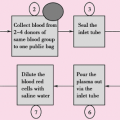in the modern medicine. Subsequently, the areas with high prevalence of the disease introduced in later medicine books mainly refer to the territories between Changkiang river and Huai river, the east of Changkiang river, Lingnan, which are similar to the results of modern filariasis investigation.
lymphatic filariasis before the founding of New China. After the liberation, the first National Health Conference in 1950 determined health working policy for New China which contained “working for the workers, farmers and soldiers”, “focused on prevention”, “combining traditional Chinese traditional medicine with western medicine”. With the guidance, health professionals and epidemiologists carried out the epidemiological investigations of lymphatic filariasis in countryside, troops, mines, and factories.
Table 6.1 The number of the endemic counties, cities of lymphatic filariasis and patients of filariasis in provinces, municipalities, autonomous regions (1980) | ||||||||||||||||||||||||||||||||||||||||||||||||||||||||||||||||||||||||||||||||||||||||||||||||||||||||||||||||
|---|---|---|---|---|---|---|---|---|---|---|---|---|---|---|---|---|---|---|---|---|---|---|---|---|---|---|---|---|---|---|---|---|---|---|---|---|---|---|---|---|---|---|---|---|---|---|---|---|---|---|---|---|---|---|---|---|---|---|---|---|---|---|---|---|---|---|---|---|---|---|---|---|---|---|---|---|---|---|---|---|---|---|---|---|---|---|---|---|---|---|---|---|---|---|---|---|---|---|---|---|---|---|---|---|---|---|---|---|---|---|---|---|
| ||||||||||||||||||||||||||||||||||||||||||||||||||||||||||||||||||||||||||||||||||||||||||||||||||||||||||||||||
the Napier stratified method, and taking county as a unit, there were 818 low and midrange epidemic areas in China which accounted 94.7%, while the high and superhigh epidemic areas accounted 5.3%.(Table 6.2 ).
Table 6.2 Prevalence rate of microfilaria in 864 counties, cities (1980) | |||||||||||||||||||||||||||||||||||||||||||||||||||||||||||||||||||||||||||||||||||||||||||||||||||
|---|---|---|---|---|---|---|---|---|---|---|---|---|---|---|---|---|---|---|---|---|---|---|---|---|---|---|---|---|---|---|---|---|---|---|---|---|---|---|---|---|---|---|---|---|---|---|---|---|---|---|---|---|---|---|---|---|---|---|---|---|---|---|---|---|---|---|---|---|---|---|---|---|---|---|---|---|---|---|---|---|---|---|---|---|---|---|---|---|---|---|---|---|---|---|---|---|---|---|---|
| |||||||||||||||||||||||||||||||||||||||||||||||||||||||||||||||||||||||||||||||||||||||||||||||||||
Bancroftian filariasis. So was the mountain area where Sichuan, Guizhou, Hunan, Hubei bordered. The epidemic areas of Bancroftian filariasis were north to Leling County in Shandong province (north latitude 37°48′), south to Sanya City in Hainan province (north latitude 18°10′), east to Zhoushan Archipelago in Zhejiang province (east longitude 122°30′), west to Tongzi County in Guizhou province (east longitude 106°50′). The endemic areas of Brug’s filariasis were north to Bo’ai County in Henan province (north latitude 35°21′), south to Luocheng County in Guangxi Zhuang nationality autonomous region (north latitude 24°50′), east to Zhoushan Archipelago of Zhejiang province (east longitude 122°30′), west to Ya’an City in Sichuan province (east longitude103°), most of which were to the south of Changkiang River.
Stay updated, free articles. Join our Telegram channel

Full access? Get Clinical Tree






